Heizung-Kühlung-System für doppelschichtigen Mantelglasreaktor
Kontaktieren Sie uns noch heute für die perfekte Lösung zur Temperaturkontrolle
In chemical experiments and industrial production, glass reactor is one of the commonly used experimental equipment. Among them, the double-layer jacketed glass reactor has better temperature control performance and experimental results due to its unique structure.
Structure of double-layer jacketed glass reactor
The double-layer jacketed glass reactor is mainly composed of an inner tank, an outer jacket, a stirrer, sealing materials and other parts. Among them, the inner tank is used to hold chemical reagents and reactants, and the outer jacket plays the role of insulation and temperature control. The design of the double-layer jacket structure makes the reactor have good thermal insulation performance, which can effectively reduce heat loss and improve the stability and safety of the experiment.
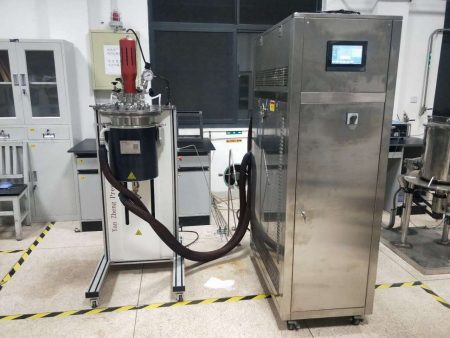
Temperature control method of double-layer jacketed glass reactor
1. Heating by electric heating mantle
Electric heating mantle heating is achieved by wrapping an electric heating mantle outside the reactor. Heating mantles are usually made of metal materials and equipped with intelligent temperature controllers that can set the temperature according to experimental needs. By heating the electric heating mantle, the reactants can react at the set temperature. Since the electric heating mantle has the advantages of uniform heating and adjustable temperature, electric heating mantle heating is one of the commonly used heating methods for double-layer jacketed glass reactors.
2. Hot water circulation heating
Hot water circulation heating is a method of heating by introducing hot water into the reactor jacket. Hot water usually enters the reactor jacket from an external pipe and circulates to keep the temperature constant. Hot water circulation heating has the advantages of high temperature control accuracy and uniform heating, and is suitable for experiments that require precise temperature control. However, hot water circulation heating requires additional water circulation equipment and heating equipment, and the operation is more complicated.
3. Oil bath heating
Oil bath heating is a method of heating by injecting thermal oil into the reactor jacket. Thermal oil has good thermal conductivity and stability, and can maintain a low viscosity at high temperatures. Oil bath heating has the advantages of high temperature control accuracy and uniform heating, and is suitable for experiments that require high-temperature heating. However, oil bath heating requires regular replacement of thermal oil and cleaning of the jacket, which is cumbersome to operate.
4. Refrigeration and heating circulator
Dynamic temperature control from -120℃ to +300℃, rapid cooling and heating with the same heat transfer fluid. Fully sealed pipelines reduce the demand for thermal fluid, and the expansion tank does not participate in circulation. The heat transfer fluid temperature output can be dynamically controlled based on the real-time temperature of the external sensor. It can handle exothermic or endothermic reactions, has high efficiency and stability, reliable and repeatable temperature control curves, magnetic drive pump, no shaft seal leakage, and controllable circulation flow pressure. Siemens PLC module, slope temperature control, multi-stage program temperature control, high precision.

Selection of temperature control methods for double-layer jacketed glass reactors
When selecting the temperature control method for the double-layer jacketed glass reactor, it needs to be considered based on the specific conditions and needs of the experiment. If the experiment requires precise temperature control, you can choose hot water circulation heating or oil bath heating; if the experiment requires rapid temperature rise, you can choose an integrated refrigeration and heating cycle machine. In addition, the safety and environmental protection of the experiment need to be considered, and safe and environmentally friendly heating methods should be given priority.
In short, the double-layer jacketed glass reactor is an important experimental equipment, and the choice of its temperature control method directly affects the success or failure of the experiment and the repeatability of the results. Therefore, in actual operation, it is necessary to choose an appropriate temperature control method according to the specific situation to ensure the accuracy and reliability of the experiment. At the same time, it is necessary to strengthen the maintenance of equipment to ensure the normal operation and service life of the equipment.
Wir bieten die Entwicklung und Herstellung kompletter Temperaturkontrollsysteme an. Von Standardmodellen bis zu kompletten kundenspezifischen Produkten bis hin zu 900 Tonnen. Wir haben uns auf den Kundenservice spezialisiert und sind bestrebt, jedem Kunden zu helfen, das optimale Temperaturkontrollsystem für seinen spezifischen Bedarf zu finden.
Wir bieten maßgeschneiderte Lösungen, die nicht dem Standard entsprechen. Es sind sowohl einzelne Kühlaggregate als auch kombinierte Kühl- und Heizaggregate erhältlich.
E-Mail: lilia@lneya.com WeChat ID: +8615251628237 WhatsApp: +86 17851209193


Kühl- und Heizsysteme (Serie SUNDI)
- Temperaturbereich: -120℃ ~ +350℃
- Hochpräzise, intelligente Temperaturregelung
- Kühlleistung: 0,5kW ~ 1200kW
- Vollständig geschlossenes System zur Verlängerung der Lebensdauer des Thermofluids
- Jedes Gerät wird mehr als 12 Stunden lang einem Belastungstest unterzogen.
| Temperaturbereich | Serie -10 ~ +150°C | Serie -25 ~ +200°C | Serie -25 ~ +300°C | Serie -45 ~ +250°C | Serie -45 ~ +300°C | Serie -60 ~ +250°C | Serie -60 ~ +300°C | Serie -70 ~ +250°C | Serie -80 ~ +250°C | Serie -90 ~ +250°C | Serie -100 ~ +100°C | ||
| Kühlleistung | 1,5 ~ 15kW | 1 ~ 200kW | 1 ~ 200kW | 0,45 ~ 200kW | 0,9 ~ 25kW | 0,25 ~ 60kW | 0,75 ~ 25kW | 0,4 ~ 15kW | 0,3 ~ 80kW | 0,2 ~ 80kW | 0,45 ~ 80kW | ||
| Hinweis: Jeder Temperaturbereich von -150℃ ~ +350℃ und jede Kühlleistung kann angepasst werden | |||||||||||||
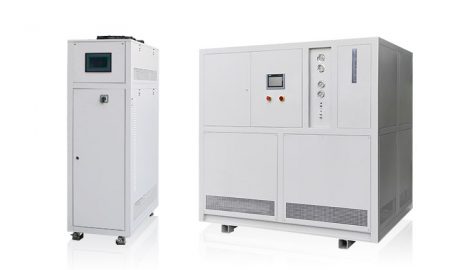
Kühl- und Heizsysteme (WTD-Serie)
- (Mikrokanal / Röhrenreaktoren spezialisiert)
- Temperaturbereich: -70℃ ~ +300℃
- Leistungsstarke Umwälzpumpe, stabilere Temperaturregelung
- Breiter Temperaturbereich zur Erfüllung der Anforderungen mehrerer Branchen
- Jedes Gerät wird mehr als 12 Stunden lang einem Belastungstest unterzogen.
| Temperaturbereich | -70°C ~ +300°C | -45°C ~ +250°C | -70°C ~ +200°C | ||||||
| Kühlleistung | 1.1 ~ 7.5kW | 1.5 ~ 5.5kW | 11 ~ 50kW | ||||||
| Hinweis: Jeder Temperaturbereich von -150℃ ~ +350℃ und jede Kühlleistung kann angepasst werden | |||||||||

Umwälzpumpen für Kühlung und Heizung
- Temperaturbereich: -45℃ ~ +250℃
- Emerson Copeland Kompressor, zuverlässige Qualität
- Selbstdiagnosefunktion, mehrere Sicherheitsschutzvorrichtungen
- Vollständig geschlossenes System zur Verlängerung der Lebensdauer des Thermofluids
- Jedes Gerät wird mehr als 12 Stunden lang einem Belastungstest unterzogen.
| Temperaturbereich | Serie -25°C ~ +200°C | Serie -45°C ~ +250°C | |||||||
| Kühlleistung | 1 ~ 15kW | 0,25 ~ 15kW | |||||||
| Hinweis: Jeder Temperaturbereich von -150℃ ~ +350℃ und jede Kühlleistung kann angepasst werden | |||||||||
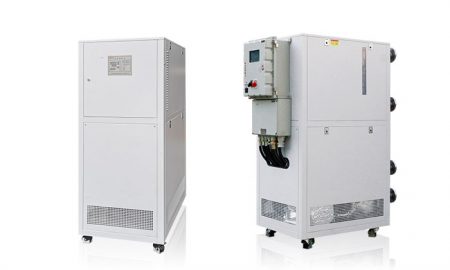
Heizungsumwälzpumpen
- Temperaturbereich: +50℃ ~ +300℃
- Große Wärmeaustauschfläche und schnelle Aufheizgeschwindigkeit
- Selbstdiagnosefunktion, mehrere Sicherheitsschutzvorrichtungen
- Geschlossenes Kreislaufsystem, kein Ölnebel bei hohen Temperaturen
- Jedes Gerät wird mehr als 12 Stunden lang einem Belastungstest unterzogen.
| Temperaturbereich | +50°C ~ +170°C (UC-Serie) | +50°C ~ +300°C (UC-Serie) | +50°C ~ +300°C (UST-Serie) | ||||||
| Heizleistung | 5,5 ~ 15kW | 3,5 ~ 130kW | 3,5 ~ 95kW | ||||||
| Hinweis: Jeder Temperaturbereich von -150℃ ~ +350℃ und jede Kühlleistung kann angepasst werden | |||||||||
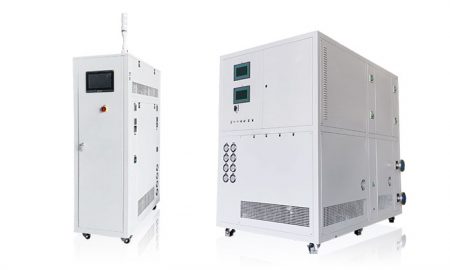
TES-Serie (Temperaturregelung für Kraftstoff- und Öltests)
- Temperaturbereich: -85℃ ~ +250℃
- Siemens PLC-Steuerung und anderes Markenzubehör
- Selbstdiagnosefunktion, mehrere Sicherheitsschutzvorrichtungen
- Vollständig geschlossenes Kreislaufsystem, kein Ölnebel bei hohen Temperaturen
- Jedes Gerät wird mehr als 12 Stunden lang einem Belastungstest unterzogen.
| Temperaturbereich | Serie -45°C ~ +250°C | Serie -85°C ~ +200°C | Serie -60°C ~ +200°C | ||||||
| Kühlleistung | 0,3 ~ 25kW | 0,25 ~ 25kW | 3 ~ 60kW | ||||||
| Hinweis: Jeder Temperaturbereich von -150℃ ~ +350℃ und jede Kühlleistung kann angepasst werden | |||||||||
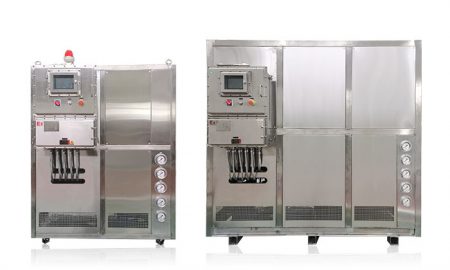
TCU Multireaktoren Temperaturkontrollsystem
- Temperaturbereich: -120℃ ~ +250℃
- Versiegelte, wiederholbare Temperaturkontrolle
- Eingebautes Thermoöl-Hilfssystem für elektrische Heizung
- Hinzufügen von Kälte- und Wärmequellen-Wärmetauschermodulen je nach Bedarf
- Jedes Gerät wird mehr als 12 Stunden lang einem Belastungstest unterzogen.
| Temperaturbereich | Serie -45°C ~ +250°C | -120°C ~ +250°C Reihe | Kundenspezifisches Temperaturkontrollsystem | RT+10°C ~ +135°C | |||||
| Heizleistung | 25 ~ 80kW | 25 ~ 80kW | Benutzerdefiniert | 25 ~ 300kW | |||||
| Hinweis: Jeder Temperaturbereich von -150℃ ~ +350℃ und jede Kühlleistung kann angepasst werden | |||||||||

Rückkühler / Umwälzkühler
Die Kältemaschine kann in verschiedenen Industrien und Labors eingesetzt werden und unterstützt kundenspezifische Designs.
| Temperaturbereich | Serie -25°C ~ +30°C | -45°C ~ +30°C Reihe | Serie -60°C ~ -20°C | Serie -80°C ~ -20°C | Serie -120°C ~ -70°C | ||||
| Kühlleistung | 0,8 ~ 30kW | 0,75 ~ 12kW | 0,4 ~ 6kW | 0,2 ~ 6kW | 0,3 ~ 5kW | ||||
| Hinweis: Jeder Temperaturbereich von -150℃ ~ +350℃ und jede Kühlleistung kann angepasst werden | |||||||||
 Mini-Kaltwassersätze / Kleinkaltwassersätze
Mini-Kaltwassersätze / Kleinkaltwassersätze
Die Kältemaschine kann in verschiedenen Industrien und Labors eingesetzt werden und unterstützt kundenspezifische Designs.
| Temperaturbereich | -18°C ~ +30°C | +5°C ~ +35°C Reihe | |||||||
| Kühlleistung | 0,35 ~ 0,9kW | 1,8 ~ 50kW | |||||||
| Hinweis: Jeder Temperaturbereich von -150℃ ~ +350℃ und jede Kühlleistung kann angepasst werden | |||||||||

Niedertemperatur-Kühlgeräte
Wir haben uns auf die Herstellung von Niedertemperaturkältemaschinen mit einem Temperaturregelbereich von bis zu -150°C spezialisiert, die den Kühlbedarf verschiedener Branchen decken.
| Temperaturbereich | Serie -25°C ~ -5°C | Serie -45°C ~ -10°C | Serie -60°C ~ -10°C | Serie -80°C ~ -30°C | Serie -110°C ~ -50°C | Serie -150°C ~ -110°C | |||
| Kühlleistung | 12 ~ 360kW | 6 ~ 180kW | 6 ~ 180kW | 4 ~ 180kW | 2 ~ 120kW | 2,5 ~ 11kW | |||
| Hinweis: Jeder Temperaturbereich von -150℃ ~ +350℃ und jede Kühlleistung kann angepasst werden | |||||||||
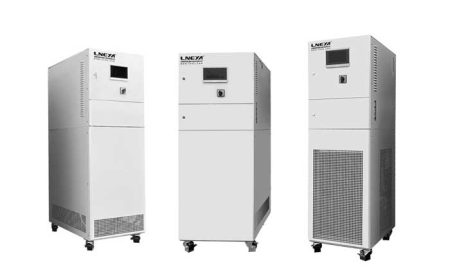
Hochtemperatur-Kühlgeräte
Die Kältemaschine kann in verschiedenen Industrien und Labors eingesetzt werden und unterstützt kundenspezifische Designs.
| Temperaturbereich | +5°C ~ +40°C | -25°C ~ +40°C | -45°C ~ +40°C | -80°C ~ +80°C | -100°C ~ +80°C | ||||
| Kühlleistung | 6 ~ 40kW | 2 ~ 15kW | 1 ~ 8kW | 0,6 ~ 3kW | 1,5 ~ 3kW | ||||
| Hinweis: Jeder Temperaturbereich von -150℃ ~ +350℃ und jede Kühlleistung kann angepasst werden | |||||||||
 LNEYA
LNEYA
 简体中文
简体中文


















































































